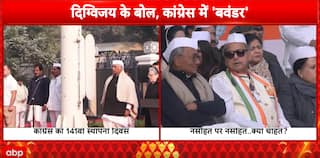Explorer
Kids' day out at 'dangerous' JNU

| New Delhi: When Class VIII pupil Ashutosh Ranjan's parents learnt his school was organising an excursion to JNU, they were aghast. "Mother asked, 'Why?' Father said it's a dangerous place: people kept fighting there. He asked why our school couldn't take us to a safer place," Ashutosh, surrounded by his classmates, said on the university campus. "I persuaded them to let me go by promising I would not talk to the university students. But here everyone is so nice," the boy from the Kendriya Vidyalaya at Pushp Vihar said. JNU today hosted its first "Jan Jan JNU Open Day", an exhibition for schoolchildren on the lines of an event popularised by IIT Delhi, the campus next door. Some 800 pupils from 11 schools participated. Ashutosh said he had enjoyed an audiovisual presentation by students of the JNU school of languages the most, where they taught the schoolchildren words from the various languages taught at the university. "I'm in Class XII and am receiving coaching for my engineering entrance, but now I want to learn French at JNU," said Aniket Kumar, from Delhi Public School, after attending the talk. Vice-chancellor M. Jagadesh Kumar, a former IIT Delhi professor, tweeted: "Universities should not remain as ivory towers. They should connect with the society. The main objective of Jan-Jan JNU is precisely this." The event's launch comes in a year the university has been in the news over its students being arrested on sedition charges and another going missing after a scuffle over hostel elections. It's in this context that the chief guest today, IIT Delhi director V. Ramgopal Rao, said that such an event was "even more important for a place like JNU". "When you look at the papers, you only hear one kind of news about JNU. But when you come here it's a completely different world," he said. "It's a normal world. It's a university like any other university.... JNU probably needs to do it much more ---- more than one Open Day a year ---- compared to IIT Delhi." Although JNU is better known for its social science departments, the focus today was on the natural sciences. The schoolchildren flocked to watch experiments with rayon fibres and demonstrations of how breathalysers work. The social sciences stalls, located in a corner, hardly drew any kids. "We weren't told that our displays would be for schoolchildren; I assumed they were for a university audience," a volunteer from the Centre for International Politics and Disarmament told this newspaper, providing a glimpse of the poor planning. "If I were a schoolchild, what joy would I get from reading the list of publications in foreign affairs?" Volunteers from the history stall tried to attract the children with their display of prehistoric tools excavated from the JNU campus. "We've tried to pose the right questions to them. What is the idea of India? Was Sanskrit ever spoken widely?" a volunteer said. In a hall inside, Ram Nath Jha of the Special Centre for Sanskrit Studies delivered a lecture on Vedic Science. "In school, you have been studying general science, which is western science," said Jha. "The problem of our country is that we do not know our tradition and heritage. Sanskrit is the oldest language not only of India, but the globe." Writing in several languages - including Egyptian, Sumerian, Mycenaean Greek and Old Chinese - existed before 1000 BC but Sanskrit is not on this list. Tamil cave inscriptions from 200 BC predate the Junagadh rock inscription of Rudradaman I, considered the earliest archaeological evidence of Sanskrit, by 150 years. So do Ashoka's edicts, written in Prakrit. There's a widely held view, though, that Sanskrit was for centuries just a spoken language. Jha had his own take on why physicist Satyendra Nath Bose exemplified India's greatness. He told the children that the Higgs Boson particle was named after Peter Higgs and Bose, and then added: "Bose belonged to the Upanishadic tradition. His family was from the Brahmo Samaj and their lifestyle was based on Upanishadic thought." Partha Ghose, physicist, author and former professor at the S.N. Bose National Centre for Basic Sciences, said: "Bose's family did not belong to the Brahmo Samaj. He never spoke to me about the Upanishadic tradition or his belief in Upanishadic thought. Nor do I know of him speaking or writing about this elsewhere." Jha may have confused Satyendra Nath Bose with the biologist-physicist Jagadish Chandra Bose, who belonged to the Brahmo Samaj, said Sibaji Raha, former director at the Bose Institute and founding chairman of the Joint Scientific Council of the GSI Helmhotz Centre for Heavy Ion Research and Facility for Anti-proton & Ion Research in Darmstadt, Germany. It wasn't just the university students explaining things. Sabhyata Garbiyal, 10, who has learnt sign language at JNU's Linguistic Empowerment Cell, was one of the volunteers from the university's side. Her school wasn't participating in the event. Sabhyata invited the other schoolchildren to ask questions that she would translate into signs. "It's simple. If you learn to sign, which you can if you come to JNU, you can learn so many things from people around you who are deaf and dumb," Sabhyata said. "Let me teach you how to sign 'Thank you'," she told this reporter and the crowd gathered around her. |
Related Video
Breaking: Digvijaya Singh’s RSS Remark Triggers Storm in Congress, Leaders Divided Over Reform Call
Follow Breaking News on ABP Live for more latest stories and trending topics. Watch breaking news and top headlines online on ABP News LIVE TV





































